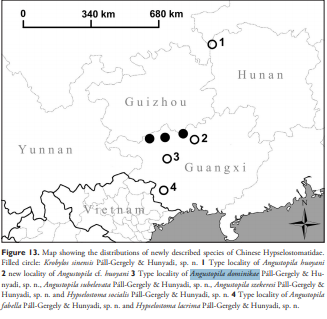Angustopila dominikae on:
[Wikipedia]
[Google]
[Amazon]
''Angustopila dominikae'' is a species of light grey, round,

land snail
A land snail is any of the numerous species of snail that live on land, as opposed to the sea snails and freshwater snails. ''Land snail'' is the common name for terrestrial gastropod mollusks that have shells (those without shells are kn ...
s, a terrestrial
Terrestrial refers to things related to land or the planet Earth.
Terrestrial may also refer to:
* Terrestrial animal, an animal that lives on land opposed to living in water, or sometimes an animal that lives on or near the ground, as opposed to ...
pulmonate
Pulmonata or pulmonates, is an informal group (previously an order, and before that a subclass) of snails and slugs characterized by the ability to breathe air, by virtue of having a pallial lung instead of a gill, or gills. The group includ ...
gastropod
The gastropods (), commonly known as snails and slugs, belong to a large taxonomic class of invertebrates within the phylum Mollusca called Gastropoda ().
This class comprises snails and slugs from saltwater, from freshwater, and from land. ...
mollusc
Mollusca is the second-largest phylum of invertebrate animals after the Arthropoda, the members of which are known as molluscs or mollusks (). Around 85,000 extant species of molluscs are recognized. The number of fossil species is est ...
in the family Hypselostomatidae. ''Angustopila dominikae'' have been found in southern China, and are considered to be one of the world's smallest terrestrial molluscs (the holotype
A holotype is a single physical example (or illustration) of an organism, known to have been used when the species (or lower-ranked taxon) was formally described. It is either the single such physical example (or illustration) or one of several ...
's shell height is 0.86 mm). This species is a tropical snail found on limestone cliffs.
Name and previous record status
The snails were named after Páll-Gergely's wife, Dominika. It was considered the “world's smallest snail”. However the current record holder, discovered in early 2022, is '' Angustopila psammion.'' ''Angustopila dominikae'' grows to, at most 0.86 mm. Some unidentified micro-molluscs found in the forests of Argao, Cebu can be smaller in size than ''Angustopila dominikae'', but these species must be further studied before they can stake claim to the title of “Worlds Smallest Snail”.Physical characteristics
The ''Angustopila dominikae'' holotype has a shell that is light grey in color, having 1.5 whorls (repeating spirals or circles) when it is a protoconch. The protoconch is finely pitted and granular and collectively radiates from the nuclear whorl and ceases at the second. This species is also extremely small, approximately 10 can fit in the eye of a needle.Discovery
This species was first found in a soil sample of limestone rocks at the base of a cliff in Guangxi, China, off the cliffs at the southern edge of Jiaole Cun and is believed to live on the cavern walls of the limestone.Diet
The diet of these snails consists of feeding on microorganisms like bacteria and fungal filaments. Jochum, a researcher, hypothesizes that the round shape of the shells of this new species may enable them to wedge themselves into tiny cracks in rocks for further food resources. It could also allow them to trap air bubbles in their shell and float in water, in case they become dislodged by rain, and also probably enables them to survive being eaten by a predator.Reproduction
These snails are most likely thought to be hermaphroditic by researchers, and change their sex based on what other snails are around their habitat.
Conservation status
Population size of ''Angustopila domminikae'' is currently unknown due to the strenuous methods needed to collect specimens of ''Angustopila domminika''. Researchers have only found the single empty shell of this species. However ''Angustopila domminikae''s conservation status is Critically Endangered (CR), because the species has only been found once, and in one place in the world. This location in China also has potential threats to its natural habitat because of quarrying in this area. However because so little is known of this species there can be no definitive known threats to this species.References
External links
* {{Taxonbar, from=Q21031233 Stylommatophora Cave snails Gastropods described in 2015